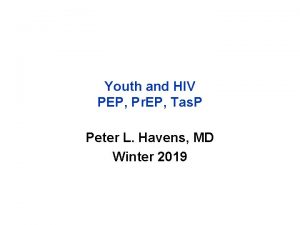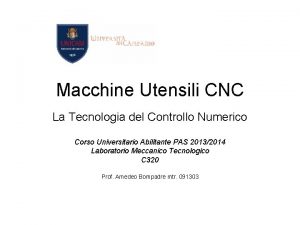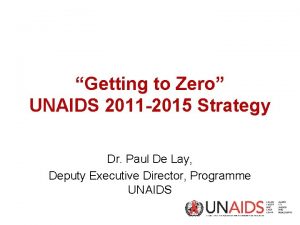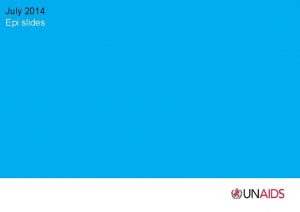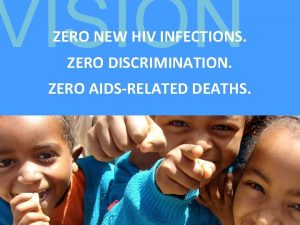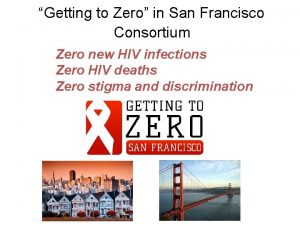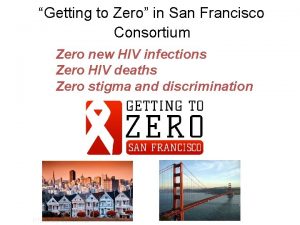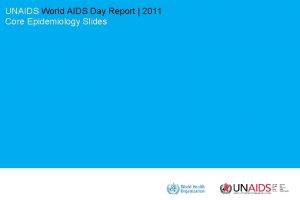Getting to Zero UNAIDS 2011 2015 STRATEGY Zero














- Slides: 14

Getting to Zero UNAIDS 2011 -2015 STRATEGY Ø Zero new HIV infections Ø Zero AIDS-related deaths Ø Zero discrimination CAJP-OAS/ Washington, April 2011

Created in 1994 by a resolution of the United Nations Economic and Social Council (ECOSOC), the Joint United Nations Programme on HIV/AIDS has been functioning since 1996. UNAIDS provides global leadership in response to the AIDS epidemic by fostering political incentives, catalyzing transformative social movements and making resources available, thereby ensuring execution of effective national strategies, multisectoral participation and respect for the human rights of those affected. UNAIDS combines the work of ten UN organizations (UNHCR, UNICEF, WFP, UNDP, UNFPA, UNODC, ILO, UNESCO, WHO, and the World Bank) and the Secretariat, following a biennial work plan to optimize coherence, coordination and the effects of the UN response to the AIDS epidemic, in support of the countries.

Three strategic guidelines for renewing the global response to HIV • Revolutionize HIV prevention • Catalyze the next phase of treatment, care and support • Advance human rights and gender equality for the HIV response




The epidemic in Latin America is concentrated in certain population groups UNAIDS

Modes of transmission in Peru, 2010 Estimate of new sexually transmitted cases each year, among different population groups MSM 54. 97% Most exposed groups Low-risk heterosexual 15. 97% Partners of clients of sex workers 6. 36% Casual heterosexual sex 6. 30% Female partners of MSM 6. 22% Partners (casual heterosexual sex) 5. 54% Injecting drug users 1. 98% Clients of sex workers 1. 33% Sex workers 0. 89% Medical injections 0. 23% Partners (injecting drug users) 0. 22% Blood transfusions 0. 0% No risk 0. 0% 0 Source: Regional UNGASS Report, UNAIDS 2010 The increase in the amount of strategic information available indicates that sex between men is the principal mode by which HIV is transmitted in Latin America. These studies need to be replicated in the other countries. 10 20 30 40 % 50 60

Legislation and sexual diversity


Focus efforts on the laws that shape the HIV responses to Number of countries and territories* F Obstacles in access to services Travel restrictions Criminalization of HIV Criminalization of sexual relations SW Laws Criminalization of IDUs Number of Countries and Territories* *Number of countries and territories with certain laws that shape the response to HIV. The data were compiled from 209 countries and territories. Not every country or territory supplied information on each type of law. Source: GNP et al.

Impact of the stigma and discrimination on the access to HIV prevention, treatment, care and support, as perceived by civil society Latin America Little or no stigma and/or discrimination (S&D) Prevention Treatment Experienced S&D when accessing services Afraid to access services Denied access to services Difficult or impossible for some other reason Sexual and reproductive health services Care and support Source: Summary report of the data received from Latin America and the Caribbean during the 2010 UNAIDS Programme Coordination Board (PCB) NGO Consultation 2010 UNAIDS Don’t know

In 2008, the percentage spent on key population groups was low or nothing when compared to the percentage spent on the general population. Source: Rodriguez-Garcia, Gaillard and Arán. Study Countries Comparison Countries UNAIDS

Partnerships in a new world Effective partnerships remain fundamental to successful and sustainable HIV responses. Partnerships give voice to the people who are infected and affected, act as a catalytic force for change, and provide accountability for political commitments. Effective partnerships must enable nationally owned responses, foster South–South cooperation and move beyond the traditional HIV and health sectors to broader development areas. These partnerships must include political alliances that link HIV movements with movements seeking justice through social change.
 Unaids pdf
Unaids pdf Unaids
Unaids Getting ahead
Getting ahead Zero defect zero effect
Zero defect zero effect Zero macchina e zero pezzo
Zero macchina e zero pezzo Corporate strategy vs business strategy
Corporate strategy vs business strategy Strategy and organization in the international firm
Strategy and organization in the international firm Chase strategy examples
Chase strategy examples Multidomestic company
Multidomestic company Aligning hr strategy with business strategy
Aligning hr strategy with business strategy Transnational strategy vs global strategy
Transnational strategy vs global strategy Masterful strategies come from
Masterful strategies come from The plan of action that prescribes resource allocation
The plan of action that prescribes resource allocation What are listening strategies
What are listening strategies Strategy formulation corporate strategy
Strategy formulation corporate strategy
